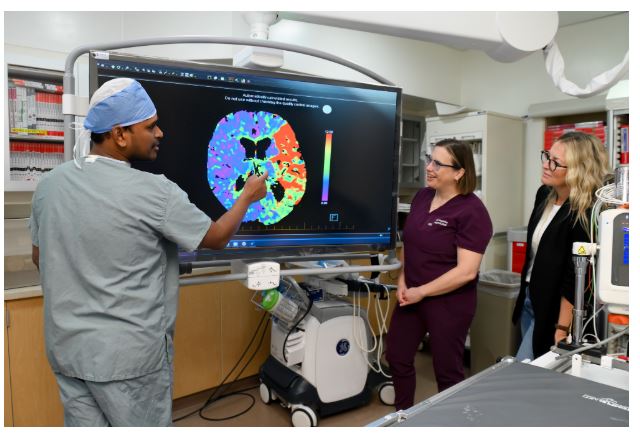Time is precious – and perhaps no more so than when someone suffers a stroke. Indeed, patients can lose millions of valuable nerve cells in the brain, called neurons, every minute they remain untreated.
Conducting a medical imaging scan on a stroke victim as soon as possible is paramount, says Jaclyn Boorman, director of Regional Brain Health and Rehabilitation Services at Island Health.
“Brain cells die very, very quickly, she says. “You need to get those images back to the right people as soon as possible. And then, if appropriate, they need treatment as soon as possible, which in some cases means a transfer to another centre. You just need everything to be as fast and seamless as possible.”
Enter artificial intelligence – or AI as it’s commonly known. The exponential growth of this machine learning technology is impacting many industries and sectors, including health care.
Since August 2023, acute stroke patients throughout the Island Health region have benefited from AI-enhanced visualization software that enables specialists to assess and act more quickly – a vital innovation, given how time is of the essence when making critical decisions about diagnoses and treatment.
Ischemic strokes, which occur when a clot prevents blood flow to an area of the brain, are the most common strokes assessed with the AI technology. However, it’s also sometimes used for hemorrhagic strokes, which involve bleeding in the brain due to a ruptured blood vessel. According to the provincial government, there are about 4,900 hospitalized cases of stroke in B.C. annually.
At Island Health, the AI-enhanced process employs a hub-and-spoke model – a first among B.C. health authorities, according to Boorman. This means that it is currently used for patients who present to hospitals located in Victoria, Nanaimo, Campbell River and Comox Valley; those sites then feed information to the Victoria-based stroke neurology team (the service may expand to other Island Health sites in the future).
When someone presents to an emergency department at one of the above sites with stroke-like symptoms – such as weakness of arms and legs, or difficulty speaking – the attending emergency physician assesses the patient and orders the needed diagnostic imaging scans. The patient is taken to the medical imaging department where the scans are completed.
The AI-enhanced software rapidly processes the scan and sends alerts to the Victoria-based team, which they receive on their cell phones or access via a medical imaging system. For example, the alert may indicate the occurrence of a large ischemic stroke.
The case is discussed by the stroke neurology team and the emergency physician to determine next steps. It’s key to note that this human element remains vital. AI, which is math-based and depends on modelling and estimates, may be invaluable – but it’s not infallible, says Dr. Vamshi Kotha, a member of the stroke team, and medical lead and section head for Interventional Radiology in the South Island. “There will always be differences, but that’s where our clinical acumen and our judgement comes in,” he says.
A major benefit is the valuable time that AI can save when it comes to assessing strokes. “Time is neurons,” Dr. Kotha says. “The quicker you can get the patient treated, the better, and the more neurons you can save.”
Dr. Janka Hegedus, medical lead of Neurology Stroke Island-wide who works closely with Dr. Kotha, estimates that about three to 10 patients per day in the Island Health region are scanned for strokes. “[The AI-enhanced process has] flagged for us the patients who are urgent and who require attention right away,” she says. “That can be quite difficult when you’re taking care of a very diverse and very distributed population. So I think that it’s really important to help us triage and help people quickly.”
She also notes that this process has enhanced communication. “We can communicate easier with our emergency room doctors. Everyone can see the same images,” says Dr. Hegedus. “When we show images to patients and families to get consent, we’re able to show them these very clear images about what’s going on.”
If it’s deemed that the stroke is treatable – for example, with an endovascular thrombectomy, which is a procedure to remove a blood clot – the patient is transferred to Victoria as soon as possible. Sadly, not every patient can be helped; sometimes too much brain tissue has died.
“It detects if there is brain that can be saved,” says Dr. Hegedus of the AI software. “So it measures for us how big the core is – that’s the part of the brain that can’t be saved. And that’s really important for us because if there’s a big core and no area to save, then we won’t take a person out of their community when there is no need or intervention to offer.”
Years of advocacy led by Dr. Kristen Attwell-Pope, medical director of Brain Health and the stroke team resulted in the approval and funding needed to move the AI project forward. Several other Island Health departments have also supported this innovative work, including the Enterprise Project Management Office, Information Management/Information Technology and General Clinical Services.
Today, the use of AI in stroke care is rapidly becoming a best practice at Island Health and elsewhere in B.C., Canada and beyond. “Our whole community is really evolving with it,” says Dr. Hegedus. “I think that’s a real positive – we can evolve and we can also give feedback when we need things to be changed.”
At the heart of this work is a desire to provide world-class stroke support and care for people throughout the Island Health region – regardless of where they may be based. “What we’re trying to do is increase equity across the system, so that you have access to imaging and you have access to the specialists quickly,” says Boorman. Adds Dr. Kotha, “I think it’s a big win for patients across the Island.”
